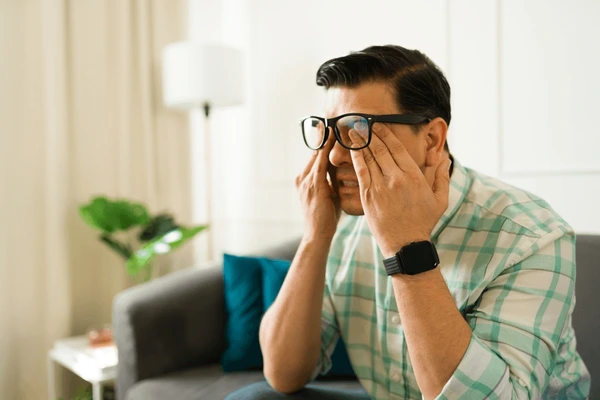Wondering how headaches relate to vision? Discover how eye strain, refractive errors, and other vision issues can trigger headaches — with expert insights from a reputed Eye Surgeon.
Understanding the Link Between Eyes and Pain
Headaches are one of the most common health complaints worldwide. While many associate them with stress, dehydration, or lack of sleep, few realise that vision problems can often be the hidden cause. The eyes and brain share an intricate connection, meaning even subtle eye issues can manifest as persistent headaches.
Understanding how headaches relate to vision not only helps in managing the pain but can also uncover underlying eye conditions that need medical attention.
Why Headaches and Vision Are Closely Connected
Your eyes and brain work in tandem to process visual information. When your eyes are forced to work harder than usual—because of uncorrected refractive errors, eye strain, or improper lighting—this extra effort can lead to tension in the surrounding muscles and nerves. Over time, this strain may result in recurring headaches.
Common scenarios include:
- Working long hours on digital screens
- Reading in dim light or poor posture
- Skipping regular eye check-ups
- Wearing outdated or incorrect eyeglasses
- Ignoring early signs of blurred or double vision
These small yet consistent stressors on your visual system can eventually cause eye-related headaches.

Common Eye Conditions That May Cause Headaches
Several vision-related problems are known to trigger headaches. Let’s explore some of the most frequent causes.
1. Refractive Errors
Uncorrected vision issues such as myopia (nearsightedness), hyperopia (farsightedness), astigmatism, or presbyopia can cause eye strain. When your eyes work extra hard to focus on objects, it results in tension headaches, especially around the forehead and temples.
Tip: Regular eye tests and corrective lenses can significantly reduce this type of discomfort.
2. Eye Strain (Asthenopia)
Spending long hours on screens without breaks is one of the leading causes of eye strain today. Digital devices emit blue light that forces the eyes to refocus repeatedly, creating fatigue in the ocular muscles.
Symptoms include:
- Headache behind the eyes
- Burning or watering of eyes
- Blurred or double vision
- Difficulty focusing after screen use
How to prevent:
- Follow the 20-20-20 rule: Every 20 minutes, look at something 20 feet away for 20 seconds.
- Adjust your screen brightness and maintain a proper distance.
3. Ocular Migraine
An ocular migraine causes temporary visual disturbances such as flashing lights, blind spots, or zigzag patterns, often followed by a headache. These episodes are usually brief but can be distressing.
Triggers may include:
- Stress
- Hormonal fluctuations
- Certain foods (like chocolate or caffeine)
- Bright lights or visual overload
If such symptoms occur frequently, consulting an eye specialist is essential to rule out retinal or neurological causes.
4. Glaucoma
Glaucoma is a condition where increased pressure inside the eye damages the optic nerve. One of its early signs can be a severe headache, often accompanied by eye pain, halos around lights, or blurred vision.
Important:
If you experience a sudden, intense headache with nausea and blurred vision, it could be an emergency and requires immediate attention.
5. Eye Muscle Imbalance (Strabismus or Binocular Vision Disorder)
When your eyes are not aligned properly, your brain must work harder to merge two slightly different images into one. This extra effort leads to fatigue and headaches, especially after reading or close-up tasks.
A vision test by an eye expert can help detect and correct this issue with glasses, vision therapy, or other treatments.
6. Dry Eyes
Chronic dryness can cause irritation and burning sensations that may extend to headaches. The lack of tear lubrication creates discomfort during prolonged reading or screen time.
To manage dry eyes:
- Blink more frequently while using screens
- Use artificial tears if prescribed
- Avoid air-conditioned or windy environments for long periods

How to Differentiate an Eye-Related Headache from Other Types
Eye-related headaches have some distinct patterns that set them apart:
- Pain typically occurs around or behind the eyes
- The headache worsens with visual activity, such as reading or using a computer
- You may notice blurred or double vision before the pain starts
- Eye fatigue or watering accompanies the headache
If these patterns sound familiar, the underlying issue could be vision-related rather than purely neurological.
Steps to Prevent Vision-Related Headaches
Adopting simple daily habits can reduce eye strain and improve your overall eye health.
1. Regular Eye Check-ups
Schedule comprehensive eye exams at least once a year. This helps detect refractive errors, glaucoma, or other eye disorders before they worsen.
2. Maintain Proper Lighting
Ensure your workspace is well-lit but not glaring. Avoid working in dim environments that make your eyes strain.
3. Follow Good Screen Habits
- Keep devices at arm’s length
- Adjust text size and brightness
- Use anti-glare screens if possible
- Take frequent breaks to rest your eyes
4. Stay Hydrated and Eat Eye-Friendly Foods
Nutrients like vitamin A, C, and E, along with omega-3 fatty acids, help maintain ocular health. Include:
- Carrots and leafy greens
- Fish like salmon
- Nuts and seeds
- Citrus fruits
5. Manage Stress and Sleep
Fatigue and stress can worsen both headaches and eye strain. Aim for 7–8 hours of quality sleep and incorporate relaxation techniques into your routine.
When to See an Eye Specialist
If you experience any of the following, it’s time to consult a specialist:
- Persistent headaches not relieved by rest or over-the-counter medication
- Blurred or double vision
- Pain around the eyes
- Light sensitivity or visual disturbances
- Nausea accompanying headaches
Early diagnosis can prevent long-term complications and protect your vision. Experts like the Best Eye Surgeon in Kolkata are trained to identify whether the headache originates from an eye condition or another systemic cause, ensuring you get the right treatment in time.

Frequently Asked Questions
Q1. Can poor vision really cause headaches?
Yes. Uncorrected refractive errors or eye strain from prolonged focus can lead to recurring headaches.
Q2. Are migraines related to eye problems?
Migraines can sometimes involve visual symptoms such as flashes or blind spots. However, they differ from headaches caused by direct eye strain.
Q3. How can I relieve eye strain at home?
Follow the 20-20-20 rule, maintain proper lighting, and keep your eyes hydrated with lubricating drops if necessary.
Q4. Should I get my eyes checked if I get frequent headaches?
Absolutely. Persistent headaches could be your body’s way of signaling an eye condition that needs attention.
Q5. Can glasses help reduce headaches?
Yes, wearing the correct prescription lenses can significantly decrease eye strain and related headaches.
A Deeper Look into the Eye-Headache Connection
Your eyes serve as an extension of your brain. Any imbalance or strain in one can easily affect the other. Eye-related headaches are more than a nuisance—they can indicate underlying health issues that deserve prompt attention.
Getting an expert evaluation helps ensure both your vision and neurological health are functioning optimally.
Professionals like Dr Tanmoy Biswas emphasise that not all headaches are “just stress.” Sometimes, the eyes tell a story that only a thorough examination can reveal.

